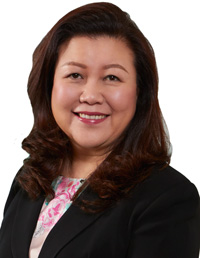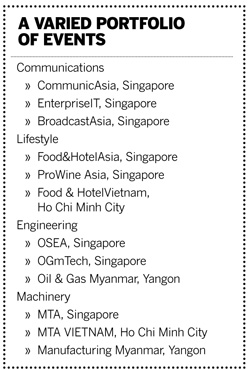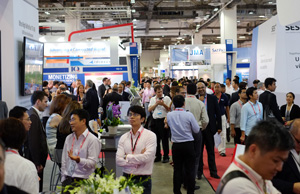Her love for the exhibitions business started in the 70s when she was a part-time booth assistant. Today, as the new chief executive of Singapore Exhibition Services, Wee talks to Karen Yue about taking the business forward
 Your resume is interesting – you’ve been with Singapore Exhibition Services (SES) since 1983, working through different departments.
Your resume is interesting – you’ve been with Singapore Exhibition Services (SES) since 1983, working through different departments.
Yes, I’ve been in various departments here, spending about seven years in each. That is a long time to learn how each department functions, and to accumulate a wealth of knowledge of this industry.
Prior to that I was temping with SES for a couple of years. In fact, I had my first taste of the exhibitions industry in the 70s when I took on a part-time job in manning a booth at an exhibition. I loved it, and then went on to work at several global exhibition companies like Reed.
Well, I’ve never ventured out of this industry and I sometimes wonder what life is like in other sectors. (Laughs)
From booth assistant to the chief executive of a major exhibition firm. That’s a motivating story for anyone hoping to make a career in exhibitions!
You could say I’ve work my way up the ranks in SES, and this has helped make transiting into my new role a smooth one. I was able to run with issues right away, and my staff didn’t have to pause and explain what was going on.
What was one crucial change in the company you were responsible for?
I was last with the conference department as a conference director. When I joined that department (in 2001), conference was not a main focus of SES because we are an exhibitions company. But I saw an opportunity there as well as the need to grow the conference department.
The industry was evolving then – it still is now – and we needed to provide more than just a marketplace to showcase products and services. We need to bring to the table knowledge and thought leadership, and have a way for policymakers to come together. The conference provides such a platform.
Six months into my role, I asked my conference producers what one must do to keep up with so many topics across so many industry sectors (SES produces exhibitions for the communications, lifestyle, engineering and machinery industries). One of my conference producers was an experienced lady and her advice to me was to devour whitepapers for breakfast. The first whitepaper I devoured was on nanotechnology, a 400-plus-page monster that took me seven mornings to read. It was extremely difficult to understand the technical aspects of certain industries and know it enough to pick out hot topics. You need heartware for this job.
We have a system that separates programme shaping, logistics and marketing. We are clear about what we need to achieve. In our case, our content creation focuses on the buyers, unlike other conference production companies that tend to lean towards vendors, as these are the people who would come into the event as sponsors. I stay away from that. I’ve set a simple mission for the team – all our KPIs are based on the buyers. We will not have a platform that only sells vendors’ products and services. We focus on things that will interest the buyers. If they are willing to pay to attend our conference, we know we are on the right track.
I’m glad to say the conference department is very profitable today. Our conferences are seeing a growing number of attendees, so the department is ready to take things to the next level. We have built a strong foundation.
What’s the next level then?
We want to grow the conferences in the verticals we operate in. For example, the conference topics presented at Food&HotelAsia (FHA) is not as comprehensive as we like it to be.
We aim to grow our conferences by expanding into the breadth of the value chain of the industry our exhibitions operate in. For example, the inaugural Future Factories and Manufacturing Asia conference, which will be held alongside MTA (a precision engineering industry event in April). Future Factories is all about digital factory, and this conference provides industry professionals an avenue to broaden their insights into Asia’s manufacturing industry.
Another example is the new conference on Central Kitchen which is to develop specific segments of the food and hospitality industry. The intention is to repeat these conferences on an annual basis.
Besides growth for the conference department, what other goals have you set for SES as the new chief?
I’ve given myself a double-digit growth for our exhibitions business. Revenue for exhibitions is tied to the sale of square metres. While we could simply grow revenue by operating more shows, I’d rather grow the size of our exhibitions to hit revenue targets. To achieve that, we have to attract more visitors to our shows. We must offer something more than the tradeshows they have in their home country.
Still, SES has grown its portfolio of shows. Years ago Stephen Tan (former chief executive, current chairman), shared with me his visions to expand into Myanmar. SES launched Manufacturing Myanmar and Oil & Gas Myanmar last year and they did great. The country is opening up for business across a spectrum of industries. Will SES be doing more in Myanmar?
We are pacing ourselves. We are not going to rush into Myanmar because first we need to have supporting infrastructure in order to grow our shows. The first Manufacturing Myanmar was held at the Myanmar Convention Centre in Yangon and we used up all available space. There is no room for growth without sufficient physical space.
Going into Myanmar is exciting and we want to be in there, but at a good pace. We will have the second edition of both Manufacturing Myanmar and Oil & Gas Myanmar this year. We will continue to keep Myanmar in our line of sight.
Does other Asian countries appeal to SES? Say, Sri Lanka, where the government is pushing for industrial and commercial growth?
Well, we did get a few offers to go there, and have done a few studies on the viability of expanding into Sri Lanka – in fact one is ongoing. I can tell you now that going into Sri Lanka this year is not a venture I’m ready for.
We’ve got to look at infrastructure. The destination’s infrastructure can pose an extremely large challenge, and by infrastructure I don’t mean just the venue. Machines that are brought into a destination for exhibition purposes will be taxed, never mind that these equipment will leave at the end of the show. Taxes and import duties are tough obstacles for show organisers and exhibitors; they cannot be waived.
Liquor tax is also another issue for us. Say I manage to recruit a big company from Italy or France to come and showcase their wines at a Food&Hotel show in a new destination, but then inform them that there will be a 40 per cent liqour tax. The company will simply say, no thanks, I’m not going there!
Transportation, logistics, the availability and size of convention halls, water and electicity supply, and security are all the things we have to consider before deciding to launch a show in a new destination.
You’ve pointed out how venue capacity can limit a show’s growth. So are there enough venues to support your dream of upsizing existing events?
When the Singapore Expo opened in March 1999 (with six halls), Stephen, who was my boss then, told me, “We need to fill it up”. I thought he was joking. How could we? But we did.
To me, at that time, the Singapore Expo was a world-class development and being able to fill it up would put SES in good standing. You could say the Singapore Expo fired me up. I was then the project director for FHA. So in April that year, FHA became the first show to use up the entire Singapore Expo. And in 2014 we were the first event organiser to fill up all ten halls of Singapore Expo (it was expanded in 2005) with FHA!
Today, we are short on space (for FHA) in Singapore because there are no expansion plans in sight (for the Singapore Expo). In Vietnam, our shows are using up the entire Saigon Exhibition & Convention Centre. It is the same situation in Myanmar.
Surely SES cannot let capacity constraints dull its growth plans. Will hosting your shows in multiple venues work?
Splitting a single event across different floors is not an attractive option because of floor loading issues. Spreading exhibits and visitors across several floors also poses many logistical issues and that is every organiser’s nightmare.
However, splitting a single event across two different exhibition centres is a solution we will consider. In fact, this isn’t new to us. We have done CommunicAsia at Marina Bay Sands and BroadcastAsia at Suntec Singapore (in 2011), with loop shuttle buses running between the two venues. That worked well although we couldn’t please everybody.
You said earlier that this job requires heartware. Has SES been able to attract enthusiatic individuals to support its growth plans? Asia’s service and business events industry is, after all, facing a manpower crunch.
The exhibition industry has been lucky because it is perceived as being glamorous. The job offers plenty of opportunities to travel and to interact with people from everywhere. This isn’t a desk-bound job. These are plus points for young people today.
For us, it is important to attract and retain the elite. It is a challenge to get people to stay. People think, “I’ve been there, done that. What’s next?”. As a company, if we are unable to offer that next level of career growth soon, staff will leave.
However, for the exhibition industry, there’s so much to learn and we need staff to be patient. I’ve been with SES and in this job for 32 years and I’m still learning.

 CommunicAsia is Asia’s largest info-communications
CommunicAsia is Asia’s largest info-communications
technology event. Last year CommunicAsia2014 and
EnterpriseIT2014 attracted over 33,000
international trade attendees throughout four days





















